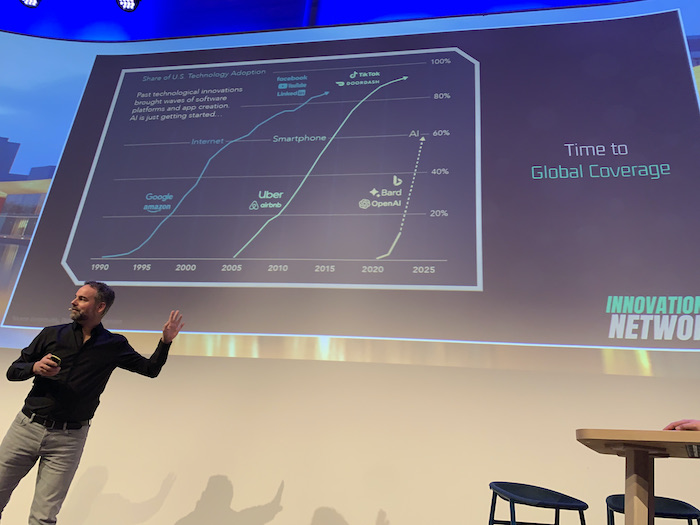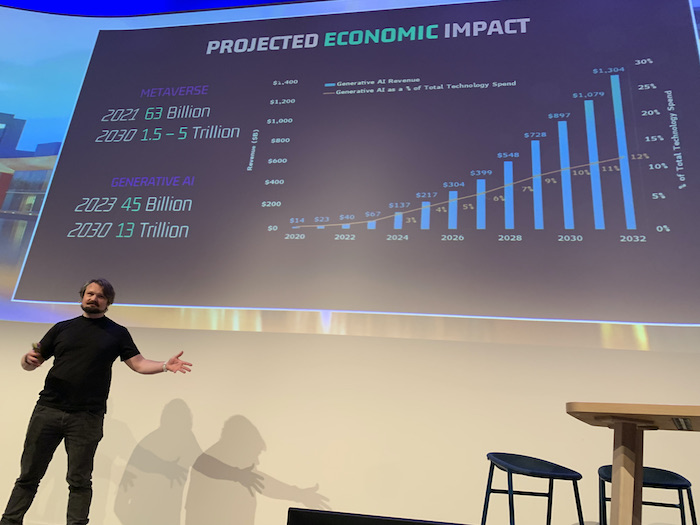(Editor’s note: This edition of the Eindhoven Business Briefing, dedicated to future tech, is part of our Tech Tuesdays series. Dispatches covers technology because so many of our highly skilled internationals are engineers and entrepreneurs.)
In a 21st century with instant access to information, artificial intelligence and streaming high-res movies on our phones, it’s good to sometimes to just take a moment and think, “Even 10 years ago, life wasn’t like this.” It’s even more amazing to think, “I can’t imagine what’s coming next.”
Well, Patrick Willer and Aragorn Meulendijks have some thoughts on that.
Willer and Meulendijks presented “Tomorrow’s Tech Today,” an hour-plus presentation followed by a panel discussion, at High Tech Campus’s Conference Center earlier this month. The presentation – one of the best we’ve heard lately – is a preview of High Tech Campus Eindhoven opening the spatial computing and immersive technologies 3EALITY Hub later this year. (American game giant Epic Games just signed on.) “Tomorrow’s Tech Today” was hosted by Phillip Werle 3EALITY Hub director.
Meulendijks bills himself as “Mr. Metaverse,” and his LinkedIn bio states he is a “future historian.”
Patrick Willer’s LinkedIn bio states he is an “explorer of new frontiers.”
Both are Salesforce alums.
Their presentation moved quickly, with a dizzying amount of information. So, we can’t bring you the entire transcript, just the highlights. But, if you get a chance to hear these guys, go for it.
Willer started with an encapsulation of all the huge tech advances since the Enlightenment and the Industrial Revolution, noting that 97.99 percent of all tech has been invented in the past 250 years. If you subscribe to the idea the Metaverse will provide the unifying theory of technology, then the best is yet to come.

The worst it’s ever gonna be
To use an ’80s American business cliché, we’re now in the middle of a paradigm shift, but this time it’s real. Artificial intelligence has seen faster adoption than any other recent consumer-facing tech including Google, Amazon, Facebook and TikTok. In just one year, Generative AI went from debut to generating text, sound, computer code, photos, video … whatever.
“Today is the worst it’s ever going to be. Let that sink in,” Aragorn said. “Because most people look at technology and they think well, today it cannot do this and today it cannot do this. But that’s not the way to look at it. Artificial intelligence is the superpower booster for all technology ever invented in history of mankind. And it’s only gonna get better, faster and better and faster and better and faster.
“And all of us can proceed because we don’t even need to learn how to code anymore.”
Version 1.0 of the Metaverse
Willer noted that of course, the Metaverse doesn’t really exist yet … or does it?
In a way, this latest convergence of AI and spatial computing started back in 1990 with the “Matrix” movie, Willer and Meulendijks contend. New technology from Meta and Apple blend the real world and the virtual world, enabling people to “meet” in the Metaverse even though they might be on opposite sides of the globe. They demonstrated with a video clip of a virtual meeting between Meta CEO Mark Zuckerberg and computer scientist/podcaster Lex Fridman, who were hundreds of miles apart. “And the crazy thing is that if you watch it, you’ll see that it looks exactly like this scene from ‘The Matrix,’ ” Willers said. It is completely photorealistic. “And the reason I’m showing it was because I wanted to show how Apple has already implemented technology that lets you look at other people in a digital space,” with realistic eye contact and reciprocal body language.
Willer predicted we’ll see the gamification of the Metaverse into marketing, something software giant Oracle, supercar builder McLaren and other companies are exploring. “Now, we have AI that can create any digital world and we have other technologies that take us into that digital world.”

Virtual generation
Sticking with the “paradigm shift theme,” Wired Magazine published an article in 2013 about the first digital generation, “the first people to ever be born in a world where they only knew the Internet and mobile phones, and they never knew a world without it,” Willers said. Now, we have the first virtual generation, Meulendijks said. “There are now children in this world growing up with artificial intelligence that is smarter than them. And it will always remain smarter.” They spend hours and hours in virtual worlds, and they will only start spending more time in these virtual worlds, he added.
The three most popular virtual world games of the moment are Fortnite, with 430 million players per day, Minecraft with 3 million players per day, and Roblox with 66 million-plus players per day, Muelendijks and Willers said.
These platforms make a lot of money … $4 billion for Fortnight and $2 billion for Roblox and still growing, according to Muelendijks. “But here’s the kicker. They’re not games. They’re not games. They are not games. These are platforms.”
Users go on and create virtual worlds, do virtual work and earn virtual money, he said. And some, such as fashion designers, earn real money.
Before AI, the expectation was, we would need thousands of developers to do hundreds and thousands of hours of development to create and maintain these virtual worlds. “But what did I show you earlier? Exactly … coding is dead,” Muelendijks said.
And so it begins ….
Yes, Apple is working on new devices beyond the Vision Pro. But small companies are developing their own technology. Willers referenced a Swiss firm called Creal. “And if you look through it, you see augmented reality that adjusts to the distance, it’s real. So, you have no eyestrain; you’re not looking at two screens snapped onto your eyes.
“No, you’re looking at something far away, it’s far away. If you’re looking at something close by, it’s close by. It’s already here, ladies and gentlemen. Within two years, we’ll have metal AI glasses. With this kind of technology that will allow us to not only hear augmented reality, but we’ll be able to see augmented reality.”
Add into the mix neuroimplants that allow people to play games and communication just by thinking about them and nothing will be the same, they said.
Even now, browsers, video, cameras and entertainment apps are all packed into smart phones. Add an interface and “we’re all Cyborgs.” Moelendijks said.
Another one bites the dust

Remember back in February when we told you about Meta’s acquisition of High Tech Campus Eindhoven-based Luxexcel, the first Eindhoven-based tech company to be acquired by a huge American tech company since Medtronic acquired Sapiens for $200 million back in 2014?
We also told you it wouldn’t be the last.
The Luxexcel acquisition was followed by Santa Monica, Calif.-based app Snap snapping up GrAI Matter Labs, which was partly based at High Tech Campus Eindhoven, though the HQ was in Paris.
Last week, Dutch expat in The Valley Sander Arts posted this on LinkedIn:
BIG NEWS today. Intrinsic ID just announced it was acquired by Synopsys Inc. Born within Philips, (Intrinsic ID’s) technology is now going to be even more pervasive than it already was. In the last 2+ years I thoroughly enjoyed being this company’s Fractional CMO / Marketing Advisor and brain trust to Pim Tuyls and his team. I salute Pim and the team with Geert Jan Schrijen. Your journey and accomplishments make you industry veterans and you wrote European and Silicon Valley history. Onwards!
Intrinsic ID, which creates cybersecurity measures based on the unique “fingerprint” of computer chips, was founded by Dutch entrepreneur Pim Tuyls and headquartered in Eindhoven at High Tech Campus.
Synopsys is – you guessed it – based in Silicon Valley. Sunnyvale, to be precise. Oh, and it was founded by another Dutch fellow, Aart de Geus. Who, of course, is from the Netherlands. Vlaardingen near Rotterdam to be precise.
We recently had a full interview with Pim, which you can read here. An interview in which Tuyls said Eindhoven startups should go to the United States sooner rather than wasting a lot of time and effort trying to raise money from European VCs. To be fair, Synopsys will keep much of Intrinsic ID in Eindhoven including R&D. But, in the interest of efficiency, shouldn’t we just have a daily flight from Eindhoven Airport straight to San Francisco so all the promising companies and entrepreneurs can start the transition from Dutch to “headquartered in Silicon Valley” early?
Brief:
• EFFECT Photonics raised $38 million in a D round led by Amsterdam-based Innovation Industries. EFFECT Photonics is developing light-based, rather than electronic, digital telecommunications and data communications networks. The company was founded by Boudewijn Docter, who is now at HighTechXL.
Co-CEO of Dispatches Europe. A former military reporter, I'm a serial expat who has lived in France, Turkey, Germany and the Netherlands.















